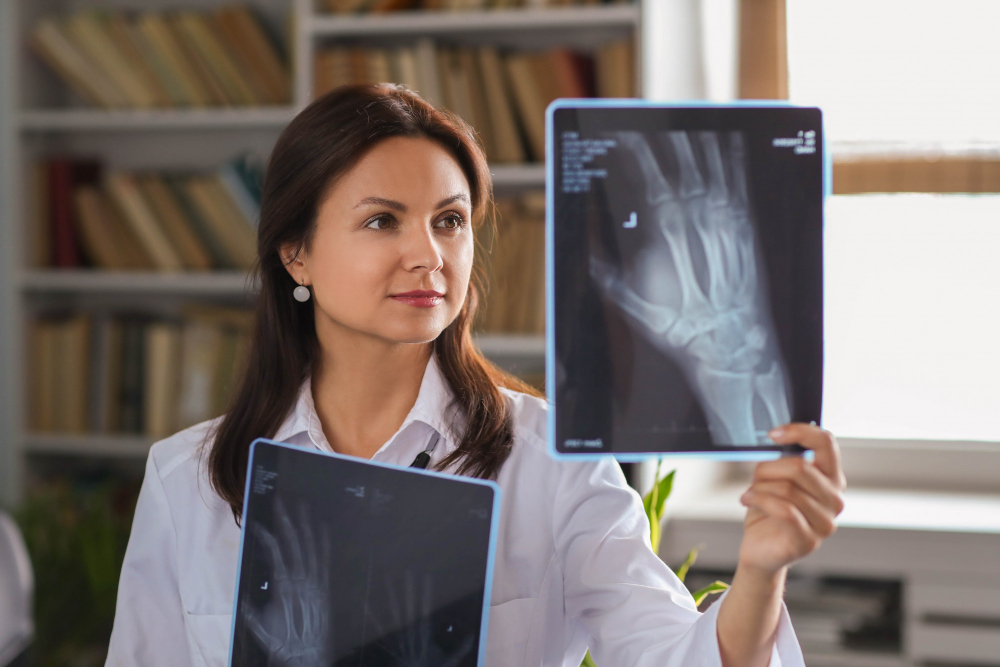Normal Hand Anatomy

Bones: The hand consists of 27 individual bones, grouped into three main sections: the wrist (carpal bones), the palm (metacarpal bones), and the fingers (phalanges). There are eight carpal bones that form the wrist, five metacarpal bones that make up the palm, and 14 phalanges that form the fingers and thumb. These bones provide structure and support for the hand’s movements.
Joints: The hand contains multiple joints that enable its wide range of movements. The wrist joint connects the forearm bones (radius and ulna) to the carpal bones, allowing flexion, extension, and side-to-side movements. The metacarpophalangeal (MCP) joints are the joints between the metacarpal bones and the proximal phalanges of the fingers. The interphalangeal (IP) joints are found between the phalanges, allowing for bending and straightening of the fingers.
Muscles and Tendons: Muscles in the forearm control the movement of the hand and fingers. These muscles are connected to the bones by tendons, which enable the transfer of muscle force to produce precise movements. Tendons are also responsible for transmitting the contraction of muscles in the forearm to the fingers, enabling activities like gripping and releasing.
Ligaments: Ligaments are strong bands of connective tissue that help stabilize and support the joints in the hand. They prevent excessive movement and provide structure to the hand’s complex articulations.
Nerves: The hand is innervated by a network of nerves that allow for sensory perception and control of muscle movements. The median nerve, ulnar nerve, and radial nerve are the major nerves responsible for transmitting signals between the brain and the hand, allowing for sensation and motor functions.
Blood Vessels: Blood vessels supply oxygen and nutrients to the hand’s tissues. The radial and ulnar arteries are the main arteries that provide blood flow to the hand, while veins carry deoxygenated blood back to the heart.
Skin: The skin of the hand is richly supplied with nerve endings, making it highly sensitive to touch and temperature. It also provides a protective barrier and helps maintain the hand’s overall integrity.
Fingernails: Fingernails are composed of a protein called keratin and protect the sensitive fingertips. They also play a role in fine motor tasks and sensory perception.
Overall, the human hand’s intricate anatomy allows for a remarkable range of motion, dexterity, and tactile sensitivity, making it an essential tool for interacting with the world around us.
SKELETAL ANATOMY OF HUMAN HAND
The skeletal anatomy of the human hand is a marvel of intricate design and functionality, embodying the remarkable capabilities that distinguish us as a species. Comprising an elaborate arrangement of bones, joints, and connective tissues, the hand serves as a testament to the complex interplay between form and function. With its unique structure and meticulous organization, the hand stands as a testament to the evolutionary adaptations that have shaped our ability to interact with the world around us.
From the robust carpals that form the wrist’s foundation to the delicate phalanges that give rise to our nimble fingers, each element of the hand’s skeletal framework plays a pivotal role in enabling the diverse range of movements and actions we perform daily. The joints that link these bones together provide both stability and mobility, while the tendons and ligaments serve as bridges that translate the commands of our nervous system into graceful and precise movements.
As we delve deeper into the skeletal anatomy of the hand, we will explore the individual components that compose this intricate masterpiece. We will uncover the functions of the carpal bones that facilitate the hand’s stability and flexibility, examine the metacarpals that form its palm and provide support for gripping and manipulating objects, and dissect the phalanges that grant us the ability to grasp, manipulate, and create.
Throughout this exploration, we will also gain insights into the interconnectedness of the hand’s skeletal elements with its muscular, nervous, and vascular systems. Together, these systems collaborate harmoniously to orchestrate the symphony of actions that define our interactions with the physical world. Whether it’s the graceful movements of a pianist, the precise strokes of an artist, or the strength and agility of an athlete, the hand’s skeletal anatomy underpins the remarkable capabilities that make us uniquely human.
Join us on a journey of discovery as we unravel the intricacies of the skeletal anatomy of the human hand, celebrating the remarkable fusion of science, art, and engineering that has culminated in one of the most extraordinary tools in the natural world.














